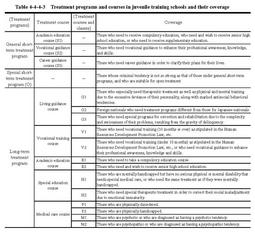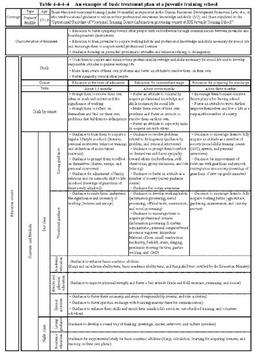| Previous Next Index Image Index Year Selection | |
|
|
2 Classification Treatment System Juvenile training schools adopt the Classification Treatment System to provide juveniles with appropriate treatment individually,paying full consideration to each person's personality,good points,future plans,physical and mental conditions,and delinquent tendencies.According to educational necessity and personal characteristics,juveniles are classified and placed under appropriate treatment by(i)types of juvenile training schools,(ii)treatment programs,and(iii)treatment courses.
(1) Types of juvenile training schools There are the following four types of juvenile training schools specified for age,level of criminal tendency,and physical and mental conditions of the juveniles to be received.Males and females are detained separately,except in medical juvenile training schools:
(i) Primary juvenile training schools For juveniles aged14or over but generally under16without any serious physical or mental disorder;
(ii) Middle juvenile training schools For juveniles aged generally16or over but under20without any serious physical or mental disorder;
(iii) Special juvenile training schools For juveniles aged generally16or over but under23without any serious physical or mental disorder,but with a strong criminal tendency;juvenile inmates under16can be admitted;and
(iv) Medical juvenile training schools For juveniles aged14or over but under26with a serious physical or mental disorderA family court decides through a hearing the type of school to which a juvenile is committed.
(2) Detention term and treatment programs Juveniles committed to juvenile training schools under protective measures may legally be detained until they become20years old in principle.
However,under certain conditions, continuation of detention is admitted.If he or she reaches20years of age within one year of his/her commitment to the school,the detention may be extended for up to one year from the adjudication of commitment.At the end of the detention period at a juvenile training school,if an inmate has a serious physical or mental disorder or still has a strong criminal tendency,and it is considered inappropriate to discharge him/her,the superintendent of the school has to apply for continuation of detention to a family court.The family court must make a decision to continue detention,specifying the term not exceeding the day when he/she turns23years old.When an inmate turns23years old and has a serious mental disorder,and it is considered inappropriate from the viewpoint of public welfare to discharge him/her,the superintendent of the school has to apply for continuation of detention to a family court.The family court must make a decision to continue detention at the medical juvenile training school,specifying the term not exceeding the day when he/she turns26years old. Based on these legal detention terms,juvenile training schools establish treatment programs that define the administrative detention terms.There are short-term programs and long-term programs,and the former are divided into general short-term programs and special short-term programs.Each of these three programs covers the following inmates. (i) General short-term programs For juveniles who are expected to be corrected and rehabilitated through short-term,continuous and intensive training for the relatively simple and easily treatable nature of their problems to be improved(the maximum term of detention is six months in principle)
(ii) Special short-term programs For juveniles who are less inclined to delinquency than those who are subject to the general short-term program and are suitable for open treatment(the maximum term of detention is four months)(iii) Long-term programs
For juveniles who are not suitable for short-term programs(the maximum term of detention is two years) Primary juvenile training schools and middle juvenile training schools use short-term programs and long-term programs,and special juvenile training schools and medical juvenile training schools use only long-term programs. The detention term of each inmate is set in a flexible manner in order to offer tailored correctional education and to ensure individual smooth rehabilitation.The detention term for long-term programs is two years at most in principle.However,a term exceeding two years may be initially determined at hearing if it is considered necessary.If it turns out later that the detention term for general short-term programs needs to be extended more than six months or that the detention term for long-term programs needs to be extended more than two years(or an initially determined term exceeding two years),the term will be extended(the term will not be extended for special short-term programs). Table4-4-4-2 illustrates treatment programs conducted in53juvenile training schools nationwide. Table4-4-4-2 Treatment programs conducted in juvenile training schools(as of April1,2005) A family court may make a recommendation to a juvenile training school,etc.with regard to a juvenile's treatment.In that case,a treatment program is determined according to the recommendation.(3) Treatment courses General short-term and long-term programs offer different treatment courses to meet the diverse educational needs of juveniles.There are three treatment courses in general short-term programs,and five treatment courses in long-term programs.The latter are further divided into several treatment classes.
Table4-4-4-3 illustrates treatment programs and courses,and their coverage. Table4-4-4-3 Treatment programs and courses in juvenile training schools and their coverage After a decision is made to commit a juvenile to a juvenile training school,a juvenile classification home chooses a school to which the juvenile is to be sent in line with the family court recommendation for the type of treatment,if any,while taking into consideration which courses are available in each juvenile training school and what kind of treatment the juvenile needs.(4) Treatment plan Each juvenile training school creates a basic treatment plan to clarify the treatment by course that they intend to implement. Table4-4-4-4 illustrates a basic treatment plan for a vocational training course(V2)at a certain male juvenile training school.
Table4-4-4-4 An example of basic treatment plan at a juvenile training school Under the Classification Treatment System,each school accommodates juveniles who share the same problems.However,each juvenile has their own special cause of delinquency and different merits that they are suppose to develop in the future.Therefore,each school creates an individualized treatment plan for each one of its inmates.The individualized treatment plan sets a concrete individualized goal to be attained by each juvenile,specified in a simple way such as"Stop abusing drugs like stimulant drugs,""Cut off relationships with bad company or organized crime groups,"and"Improve relations with your parents,"etc.It also contains contents and methods of education that are most suitable for attaining that goal.For early attainment of individualized goals,it is important to give juveniles incentive to improve themselves,expecting their voluntary efforts to effectively facilitate the improvement.For that purpose,juvenile training schools adopt the progressive grade system,classifying inmates into the first grade(upper/lower),second grade(upper/lower)and third grade.Those newly admitted are placed in the lower second grade and then move up to higher grades according to their improvement. |


